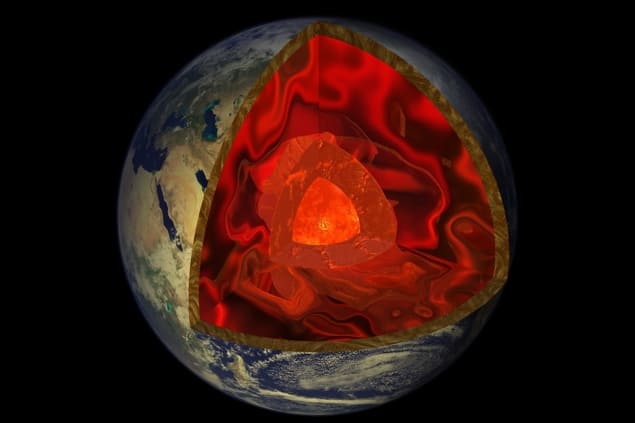
Extreme conditions close to those found within the Earth’s outer core have been created in the lab by planetary scientists in Japan. Researchers led by Yasuhiro Kuwayama at the University of Tokyo created the temperatures and pressures needed for their experiment using a highly specialized diamond anvil. Their discoveries could lead to a better understanding of the composition and behaviour of the Earth’s outer core, and perhaps even the interiors of other planets.
The Earth’s core begins about 3000 km below the surface and much of what we know about it comes from looking at seismic waves from earthquakes that have travelled through the centre of the Earth. The core’s properties have also been studied by doing computer simulations and experiments that subject materials to extreme temperatures and pressures. Research has revealed that the centre of our planet is separated into a solid inner core composed mainly of an iron-nickel alloy and an outer core dominated by liquid iron.
Now, Kuwayama’s team has increased our knowledge of the outer core using a diamond anvil, which exploits diamond’s almost unparalleled hardness to subject samples to extremely high pressures and temperatures. In their study, they compressed a liquid iron sample to pressures of up to 116 GPa and heated it to of 4350 K. While 4350 K is believed to be a typical temperature within the outer core, 116 GPa is slightly lower than the pressure expected at the top of the outer core.
Sustained pressure
An important feature of this latest research is that this extreme pressure and temperature can be maintained indefinitely – at least in principle. This is unlike previous studies in which extreme conditions were only sustained for a few microseconds. The team squeezed a tiny liquid droplet of liquid iron to 116 GPa and then heated it to 4350 K using an infrared laser. Then the team probed their sample’s properties in detail, primarily by doing X-ray scattering experiments at RIKEN’S Spring-8 synchrotron in Hyōgo prefecture.

X-rays suggest lower-mantle magma could be stabilized by heavy elements
After combining their observations with existing data, Kuwayama and colleagues compared the measured thermodynamic properties of their high-pressure, high-temperature liquid iron to what is known about Earth’s outer core. They found that the Earth’s outer core must be around 7.5% less dense than the liquid iron, suggesting that it must contain a high abundance of lighter elements that have yet to be identified. The team also found that material in the outer core must flow around 4% more easily than liquid iron, although both materials display a similar resistance to compression.
Kuwayama’s team says that its work offers important new insights into the physical properties of Earth’s core. Their work could also inform future studies of other planetary cores – which even within the solar system, encompass a rich variety of compositions, structures, and relative sizes. As Kuwayama concludes, “we were pleasantly surprised by how effective this approach was and hope it can lead to a greater understanding of the world beneath our feet”.
The research is described in Physical Review Letters.



